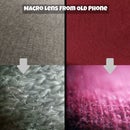Introduction: How To: Time-lapse
What is a time-lapse? A time-lapse is a video created by compiling a set of pictures shot after each other on a set interval. This can create a video which shows motions which may take hours to take place unfold in a few seconds or minutes. You might be thinking, why not just fast forward a video? Time-lapse is preferred over fast forwarding a video because time-lapses usually span over multiple hours. Making a video of the same length would take up a lot more storage space as compared to a series of photos. Another reason is that most, if not all, cameras and smartphones have lower resolution and detail in videos as compared to photos, so making a time-lapse results in a video with a higher resolution and amount of detail. Alright, that's enough introduction, lets move on to the steps of creating a time-lapse.
Step 1: Things Needed to Make a Time-lapse
Making a time-lapse requires just a few things.
1. DSLR, SLR, smartphone or any other camera capable of making a time-lapse.
2. Intervalometer (Only for some DSLRs and SLRs). This can be substituted with a laptop (Instructions in further steps).
3. Tripod. This is not necessary but using it results in a smooth, professional end result.
That's about it. (Note: An intervalometer is only required for some cameras which do not have the time-lapse function built in).
Step 2: Pre-timelapse Calculations (part 1)
So, before you start making a time-lapse you need to do some calculations. The things needed to be calculated are the shooting interval, clip length, event duration, fps of finished video and the storage size that the pictures will use.
The shooting interval refers to the pause after which a new picture is taken. This can vary from situation to situation. For example, if you are shooting moving traffic, fast moving clouds (faster than usual) or a time-lapse of your trip to somewhere from inside your car, the interval you would want is 1 second. If you are shooting sunsets/sunrises, slow crowds or clouds at normal speed you would want an interval of about 1-3 seconds. Shooting moving shadows, the sun moving across the sky or stars will require you to have an interval of about 15-30 seconds (15-60 for stars, 30 is preferred). Growing plants will require you to have an interval of about 90-120 seconds while construction will require an interval of about 5-15 minutes.
Clip length refers to the length of the final video. This should be a few minutes at most because watching a time-lapse longer than that tends to be boring (unless it's a compilation of different time-lapses). You can take inspiration from Youtube.
Step 3: Pre-timelapse Calculations (part 2)
Event duration means how long the event you are time-lapsing is going to last.
FPS means 'Frames per Second'. This means how many pictures of your time-lapse there will be in one second of the finished video. This is usually 24 or 30. If you end up with too many pictures you can always make the fps higher to shorten the final video according to your needs. This can be adjusted according to your needs but keep in mind that if you go below 24 fps, the final video will be choppy and unpleasant to watch. Increasing the FPS above 24 is perfectly fine as it doesn't decrease the smoothness of the final video (actually makes it smoother).
Storage size means the size that all of the photos of the time-lapse will take on the camera. This can sometimes be a problem because if you are shooting at a high resolution, the pictures can be of a large size and storing these on your mobile or camera can be a problem. If there is not sufficient space to store the images, the time for which you will be shooting can be decreased, the megapixel count can be decreased or the shooting interval can be increased (which should not be done unless you really need to do so). If you are shooting in RAW, you can switch to JPEG to reduce the file size.
I found this website (http://www.photopills.com/calculators/timelapse) to be very useful when I was creating my time-lapses. It is very well put-together and contains all of the elements that we talked about.
Step 4: Camera Settings
Camera settings play a vital role in getting a professional looking time-lapse. The settings that need to be adjusted are ISO, Aperture, Exposure and White Balance, Shutter Speed and Output Format. Throughout the time-lapse, the camera needs to be in manual mode because in automatic mode, the camera keeps readjusting the picture settings and this results in a choppy time-lapse.
ISO refers to the sensitivity of the camera to the light. This is adjusted by changing the ISO and taking taking several sample photos. When you find the perfect image, set the ISO to the ISO at which the image was taken. Keep in mind that the higher the ISO will be, the more noise or distortion there will be in the image. It is recommended to keep the ISO at a low amount and not increase it (unless needed) so that you end up with a noise-free time-lapse.
Aperture means how wide the lens opening is through which the light passes. The lower the aperture is, the more amount of light will pass through the lens. This can be adjusted if you are not getting enough light for your image and do not want to increase ISO which can introduce noise. This can be increased or decreased according to your needs as this does not have an effect on the image quality.
Exposure refers to the brightness of an image (increasing it does not increase the brightness of the image as increasing the ISO would, it just gives the image a white tint) and the White Balance refers to the how 'cool' or 'warm' an image is. Once again, take sample images and settle on an amount that you like.
Shutter Speed refers to the amount of time for which the camera shutter is open for taking an image (increasing the shutter speed slightly and decreasing ISO will give you a more smooth and silky-ish image of moving objects such as people or water). Keep in mind that this MUST NOT be more than the shooting interval as that will result in skipped frames and an overall bad time-lapse (shutter speed for shooting stars should be 20-30 seconds). The shutter speed can be used as an alternative to increasing ISO because increasing it results in higher light sensitivity without introducing noise. The downside of increased shutter speed is that if the camera is not on a tripod and a stable base, and the camera shakes while the shutter is open, it will result in a 'stretched' image or an image unsuitable for time-lapse. Once again, this can be adjusted by taking sample photos but it should not be increased a lot as that will risk introducing camera shake into the image.
Output format refers to the format in which the camera stores an image after it is taken. It is recommended to use RAW format because it can be easily edited in post-processing to give you a better time-lapse but this also increases file size. So, if you have the skills of editing RAW files and the storage space to store them, shoot your images in this format otherwise choose JPEG.
Step 5: Shooting the Time-lapse (Part 1-Set Up)
Now comes the time to actually set up the time-lapse. The first thing you have to do is set up your camera for the time-lapse. This is the time at which you adjust the camera settings (Examples included for various situations at the end of the instructable) and frame the shot.
First of all, you need to see if your camera has the time-lapse (sometimes named intervalled shots or something like that) function built in. If so, set it up with the interval needed for the shot. If not, use an intervalometer provided that you have one. If you do not have an intervalometer, it can substituted with a computer/laptop and the right software.
For Nikon users, this will be Sofortbildapp(Mac),D-Software Cam Control (Windows) or Nikon Capture 4.0 (Windows & Mac). Canon users can use DSLR Remote Pro(Windows & Mac) and inPhoto Capture(Windows). These softwares however require a computer to be nearby (or laptop).
After, that is set-up, the time comes for the picture settings to be set on the cameras. These can be adjusted by yourself. If you prefer pre-made setups, I will include example settings for most of the situations at the end of the instructable. (Note: Don't forget to turn off the autofocus as that will cause the time-lapse to look a bit choppy-ish)
Step 6: Shooting the Time-lapse (Part 2-Shooting)
Now comes the fun part, shooting the time-lapse. First of all you need to setup your tripod and camera on a sturdy surface which will not vibrate of shake and properly mount your camera to the tripod. If you are shooting the time-lapse in open sunlight and high temperatures, you can put an umbrella over the camera to protect it from the sunlight (also over the laptop if you are using one).
If you are using a smartphone, you will need an app to shoot the time-lapse. The app that I personally use is Lapse-It (Android & IOS). Options for IOS include Lapse it GorillaCam, iMotion, ProCam4, Fast Camera and Camera+. Android options include Lapse it, Timelapse and many others. Just search on the App Store or Play Store and choose an app that you think is appropriate. I recommend Lapseit for both Android and IOS as I have had a good experience using it. Most time-lapse apps are paid but there are also some free ones. The free ones although most of the times have limitations.
You should shoot in a place where there is little or no chance of the camera falling, being hit or stolen. Touching the camera of the lens should also be minimized and if you do have to touch the camera, do it very lightly, as to not cause shake which can appear in the final video and ruin it.
When framing the shot make sure that the time-lapse has something interesting in the foreground which is out of focus such as a tree or something and that you are not simply shooting clouds or stars etc. because that can result in an un-interesting final product. If you search 'star time-lapse' on Google Images you will see that ALL of the time-lapses have a foreground item.
Also, make sure that you have extra batteries and that you camera is fully charged so that if you are shooting for long periods, the camera does not turn off. Another thing to be taken care of is that whether you have enough space in your memory card and that you have brought more memory cards with you. The use of a slider can create an interesting effect in the time-lapse.
That's about it for the shooting part.
Step 7: Compiling and Processing
Now that you have the time-lapse shots, the time comes to compile them into one video and do some editing. If you are using a smartphone, the time-lapse apps usually combine the photos into a time-lapse by themselves. Softwares that you can use include VirtualDub, Windows Movie Maker, Adobe Lightroom (with this plugin) and Automator etc.
In processing, you can remove the faults that may have occurred through the time-lapse like flicker (due to changing amounts of lights), color temperature problems and many others. This is an important part of making a time-lapse. I used to make time-lapses with a mobile (don't own a DSLR) so I'm not really sure about this part. I would suggest looking up tutorials on Youtube as there are hundreds of amazing tutorials. I did not do much processing (just cropping and stuff) to my time-lapses (maybe that's why they don't look so good).
Step 8: Conclusion
I tried to cover all I could in this instructable, if you need help don't hesitate to ask in the comments. Making a time-lapse isn't that hard, in fact it is pretty interesting. Making time-lapses can also teach you the basics of using a camera. It is a great hobby for people who are new to photography (even professionals) and results in good looking content without consuming much time. That's about it for the instructable, the next step will include examples of camera settings and some other instructions about shooting different types of time-lapses (Don't forget, Google is your friend). Thanks for reading the instructable and if you make a time-lapse post it in the comments or link it as I would love to see it. If you liked this instructable, please vote for it in the photography contest. :)
Step 9: Examples
Star Time-lapses:-
Try to use as wide angle lens as you have for this type of time-lapse as wide-angle star time-lapses look really beautiful. Try to keep a tree or an interesting stone etc. in the foreground which is out of focus. Also, try to shoot when there is a clear sky.
Shooting Interval: 20-60 seconds. This can be adjusted so that you do not end up with too little shots. Too many shots are fine. Another thing to be kept in mind while adjusting this is the shutter speed.
ISO: 1,600–6,400 (Try to go as high as you can without introducing an unacceptable amount of noise)
Aperture: As low as you can. (Low=Wide opening)
Shutter speed: 20-30 seconds (Less than shooting interval)
Focus: Use the Live View zoom and magnify feature to make this object larger, and then turn the focus ring until the star looks sharp. (Focus at infinity)
White Balance: Lock this at a set point you find appropriate.
For reference: http://makezine.com/projects/how-to-capture-breathtaking-time-lapses-of-the-night-sky/.
I have also attached a sample stars time-lapse. (https://www.youtube.com/watch?v=meo9aBB9RvA)
Cloud Time-lapses:-
Shoot in a place where there is a lot of cloud movement. Also, look for clouds which appear colored instead of plain white boring clouds.
Shooting Interval: 2-3 seconds.
ISO: As low as you can without making the picture look dimly lit.
Aperture: A point at which the picture looks properly lit.
Shutter speed: Find a balance between this and the ISO as to reduce noise as much as you can but do not increase it a lot as the shooting interval for clouds is also pretty low. Also, keep in mind that you should only increase the shutter speed if the camera is properly mounted on a steady tripod which is on a stable surface.
Focus: Focus at a point where the cloud appear to be sharp and lock it there, do not use autofocus.
White Balance: Lock this at a set point you find appropriate.
I have also attached a sample clouds time-lapse. (https://www.youtube.com/watch?v=T0t4luiIHoU)
More:-
I could not add more examples due to the lack of time but do not forget that Google is your friend. You can find camera settings and stuff of different types of time-lapses by using Google. If you can't find something and need help, then post it in the comments and I will try to help you.
I have attached some of the time-lapses I have made. They are nothing really spectacular as I did not have a DSLR to work (and a small area in which I could shoot the time-lapses) with but I still think they are pretty cool :D.
Be creative. I particularly liked clouds and stars time-lapses but there are a lot more types of time-lapses you can make (couldn't make stars time-lapse because I was using a smartphone ;-;) e.g ants coming towards something sweet like syrup, ice melting, construction, someone aging (with a picture interval of a few seconds), a tree aging etc. Also, don't forget, if you do not have a DSLR it does not mean you can't make time-lapses. Smartphones do almost the same job just with a little bit quality loss. I have seen some people make better time-lapses from their mobile than people with DSLRs can.

Runner Up in the
Photography Contest 2017













